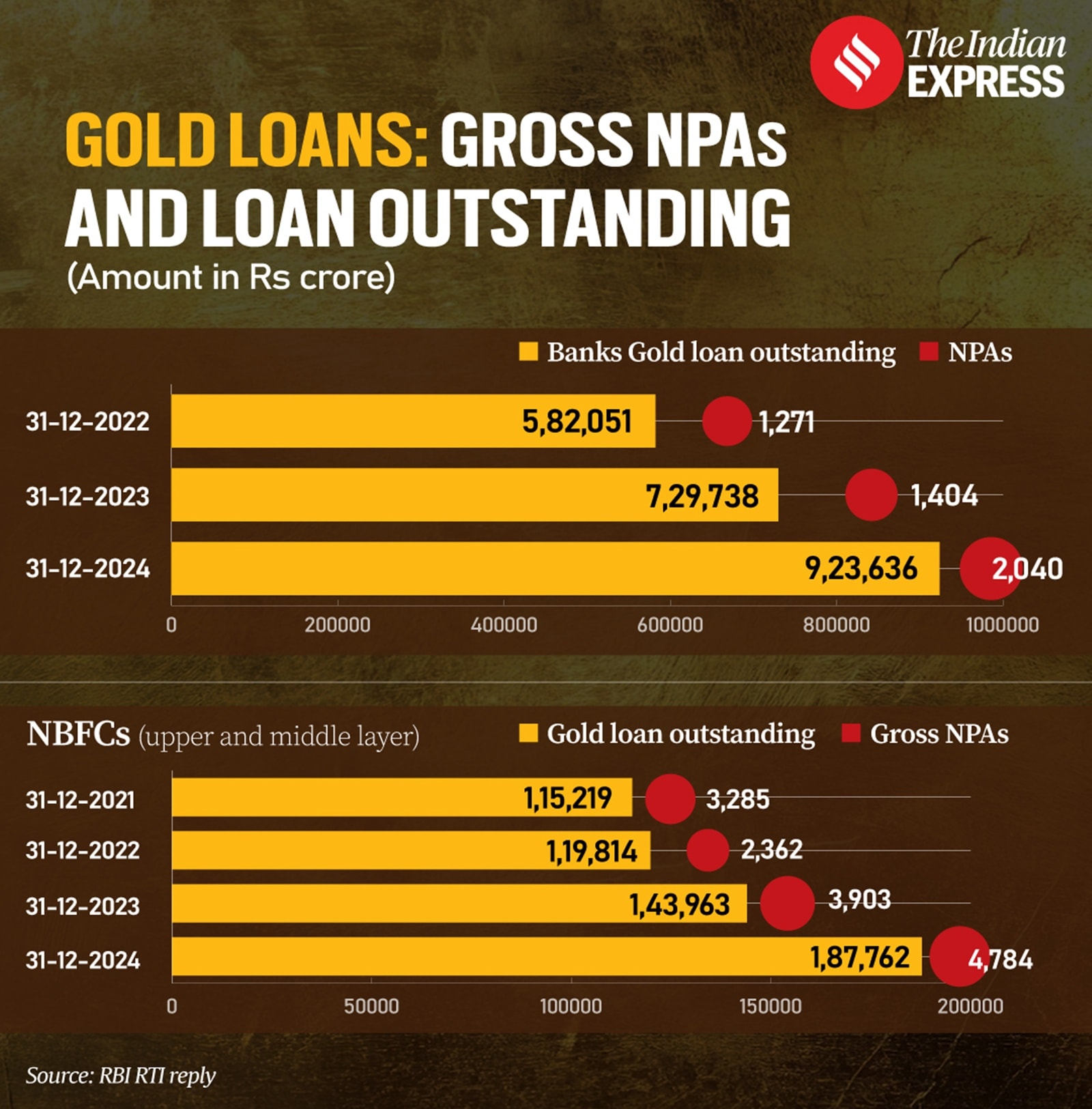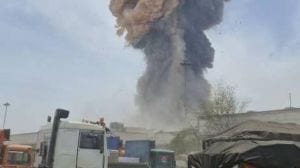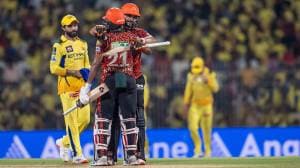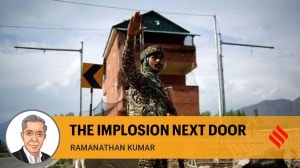UPSC Key: Cheetah, Irregular Moons and Jallianwala Bagh Massacre
Why Semiconductor is relevant to the UPSC exam? What is the significance of topics such as Supreme Court interpretation on Governor's assent to Bills, SC sub-categorisation and Mehul Choksi on both the preliminary and main exams? You can learn more by reading the Indian Express UPSC Key for April 15, 2025.
 UPSC Key April 2025: Here's what you should be reading from the April 15, 2025 edition of The Indian Express
UPSC Key April 2025: Here's what you should be reading from the April 15, 2025 edition of The Indian Express Important topics and their relevance in UPSC CSE exam for April 15, 2025. If you missed the April 14, 2025 UPSC CSE exam key from the Indian Express, read it here
FRONT PAGE
Belgium confirms Mehul Choksi’s arrest, request for extradition by India
Syllabus:
Preliminary Examination: Current events of national and international importance.
Mains Examination: General Studies II: Bilateral, regional and global groupings and agreements involving India and/or affecting India’s interests.
What’s the ongoing story: The Belgium government on Monday confirmed that fugitive jeweller Mehul Choksi (65) has been arrested in Antwerp following an extradition request by Indian investigation agencies.
Key Points to Ponder:
• Who is Mehul Choksi?
• What’s the Mehul Choksi case?
• What is Choksi accused of?
• Why New Delhi has pressed for his extradition from Belgium?
• What is the meaning of fugitive economic offender?
• What are the objectives of Fugitive Economic Offenders Act 2018?
• What do you mean by extradition?
• India-Belgium Extradition Treaty—What you know about the same?
• Can the extradition be refused?
• In its effort to bring Choksi back, what are some hurdles that India could face?
Key Takeaways:
• Wanted for his alleged involvement in the Rs 13,000-crore Punjab National Bank (PNB) loan fraud case, Choksi fled India in January 2018.
• “The Belgian Federal Public Service of Justice can confirm that Mr Mehul Choksi was arrested on Saturday, April 12, 2025. He is being detained in anticipation of further judicial proceedings. Access to his legal counsel has been assured,” a spokesperson of the Belgian Ministry of Justice told The Indian Express.
• India and Belgium have a long-standing extradition treaty. “Following his detention on Saturday, a team of three to four senior officials of CBI have been asked to travel to Belgium to complete all the procedures and documentation work,” said sources.
• Choksi, his nephew and fugitive diamond merchant Nirav Modi, and their family members were among those booked by the Central Bureau of Investigation (CBI) and Enforcement Directorate (ED) in 2018 for perpetrating the alleged loan fraud at PNB’s Brady House branch in Mumbai.
• Nirav Modi, declared a fugitive economic offender, has been lodged in a London jail since he was held by the authorities there in 2019 on the basis of a legal request made by the ED and the CBI. He is contesting extradition to India.
• Both the CBI and ED have filed multiple chargesheets and prosecution complaints against Choksi and Nirav Modi.
Do You Know:
• India first signed an extradition treaty with Belgium in 1901. The treaty allows extradition on the basis of “dual criminality”, including for financial crimes. Dual criminality essentially means that an individual can be extradited only if her offence is punishable in both jurisdictions involved.
• The treaty, however, prohibits extradition for offences of political nature or in cases where the individual in question can prove she is being prosecuted in the requesting country for political reasons. It also says that the fugitive arrested shall be released if the requesting country fails to present evidence of culpability within two months.
• In 2020, India and Belgium signed the Mutual Legal Assistance Treaty for better cooperation on fugitives.
• Choksi was arrested in Belgium on the requests of the Central Bureau of Investigation (CBI) and the Enforcement Directorate (ED), which are probing the case against Choksi. Once the extradition process begins, teams from both agencies will visit Belgium, and prepare a case in accordance with the country’s laws.
• However, it is unlikely that Choksi will be back in India any time soon, if at all. While extraditions are typically lengthy legal processes, this is especially true in Europe.
• Choksi’s arrest in Belgium showcases India’s diplomatic heft, but whether it can also fast track the legal process remains to be seen. India’s experience with the UK, for the extradition of Choksi’s nephew and co-accused Nirav Modi and former Kingfisher Airlines owner Vijay Mallya, has not been encouraging. Mallya left India in 2016, while Modi fled to the UK in 2018.
Other Important Articles Covering the same topic:
📍Mehul Choksi arrested in Belgium. What happens now?
Panel gives nod to shift cheetahs from Kuno park to Gandhi Sagar
Syllabus:
Preliminary Examination: General issues on Environmental ecology, Bio-diversity and Climate Change
Mains Examination: General Studies III: Conservation, environmental pollution and degradation, environmental impact assessment.
What’s the ongoing story: Even as the Centre is in talks with Kenya, South Africa and Botswana to translocate the next batch of cheetahs to Madhya Pradesh, the Cheetah Project Steering Committee is learnt to have cleared the relocation of some of the cheetahs from Kuno National Park to Gandhi Sagar Wildlife Sanctuary.
Key Points to Ponder:
• Cheetah in India- Background
• Extinction of Cheetah from Indian Landscape-know the reasons
• Supreme Court of India on Translocating Animals-know in detail
• Trans-continental translocation of Animals-know the Issues and Challenges
• How Reintroduction of the cheetah in India was executed?
• Map Work World-South Africa, Kenya, Namibia and Botswana
• Map Work India-Kuno Palpur National Park and Gandhi Sagar Wildlife Sanctuary
• Why relocation of some of the cheetahs from Kuno National Park to Gandhi Sagar Wildlife Sanctuary?
• What are the concerns about the relocation of some of the cheetahs from Kuno National Park to Gandhi Sagar Wildlife Sanctuary?
• Cheetah Project Steering Committee—Know its role, vision and powers
• National Tiger Conservation Authority (NTCA) and Cheetah Project Steering Committee—Is there any difference between the two bodies? If yes, what are they?
Key Takeaways:
• The steering committee, however, advised that the relocation of the cheetahs to Gandhi Sagar, although in the same state, should be carried out with care, taking into account stress factors like the heat while moving them by road. Gandhi Sagar is about 300 kilometres from Kuno.
• The decision, taken at a meeting last week, comes even as concerns linger over availability of adequate prey and the presence of leopards, the competing co-predators.
• “It was discussed and agreed that a few cheetahs could be moved to Gandhi Sagar soon,” said a source aware of the developments.
• Gandhi Sagar Wildlife Sanctuary has been earmarked as an important link for long-term conservation of cheetahs, with the aim to establish a metapopulation of 60-70 cheetahs across the Kuno-Gandhi Sagar landscape, spread across Madhya Pradesh and Rajasthan.
• For over a year now, the Madhya Pradesh forest department has been preparing Gandhi Sagar for the introduction of cheetahs. Although it was to be a home for the next batch of African cheetahs, talks between India and African nations have not materialised yet.
• In the first phase, the plan is to release four-five cheetahs into a fenced area in the western part of the sanctuary. An area of 64 square kilometres has been cordoned off and leopards have been moved out to prevent conflict between the two wild cats.
• It is yet to be finalised if the cheetahs to be moved to Gandhi Sagar would be those which were released into the wild at Kuno, or the others which are still inside large enclosures. Of the 26 cheetahs at Kuno, 17 are in the wild and nine remain in enclosures.
• A deficit of prey at Gandhi Sagar has been a concern and the steering committee discussed the ongoing efforts to augment prey base through introduction of chital from other forests of Madhya Pradesh. For in-situ (on-site) breeding of prey, there are herbivore enclosures at Gandhi Sagar.
Do You Know:
• Project Cheetah kickstarted in 2022 with the translocation of eight cheetahs from Namibia and 12 from South Africa to Kuno National Park. The project has faced setbacks with the deaths of eight of these cheetahs and five cubs born in Kuno.
• The Cheetah Project Steering Committee was constituted by the National Tiger Conservation Authority in May 2023 to review and monitor the project, and also act as an advisory body.
• Cheetahs are among the oldest of the big cat species, with its ancestors going back about 8.5 million years. It is listed as “vulnerable” by the World Conservation Union (IUCN) Red List of Threatened Species. Two subspecies, the Asiatic cheetah and the Northwest African cheetah, are listed as “critically endangered”.
Other Important Articles Covering the same topic:
📍Explained: How cheetahs went extinct in India, and the plan to reintroduce them into the wild
Previous year UPSC Prelims Question Covering similar theme:
1. Consider the following: (2012)
1. Black-necked crane
2. Cheetah
3. Flying squirrel
4. Snow leopard
Which of the above are naturally found in India?
(a) 1, 2 and 3 only
(b) 1, 3 and 4 only
(c) 2 and 4 only
(d) 1, 2, 3 and 4
EXPRESS NETWORK
Telangana becomes first state to implement SC sub-categorisation
Syllabus:
Preliminary Examination: Indian Polity and Governance-Constitution, Political System, Panchayati Raj, Public Policy, Rights Issues, etc.
Mains Examination: General Studies II: Welfare schemes for vulnerable sections of the population by the Centre and States and the performance of these schemes; mechanisms, laws, institutions and Bodies constituted for the protection and betterment of these vulnerable sections.
What’s the ongoing story: Telangana’s Congress government Monday issued a gazette notification that formally implemented Scheduled Caste sub-categorisation, popularly called reservation within reservation. According to the notification, Scheduled Castes in the state will be divided into three categories – Group I, II and III.
Key Points to Ponder:
• What is the sub-categorization of SC?
• What is sub Categorisation within castes?
• What is the Supreme Court Judgement on SC sub Categorisation?
• Telangana government recently formally implemented Scheduled Caste sub-categorisation, popularly called reservation within reservation—what are the highlights of this decision?
• What are the affirmative action taken by Constitution of India for Scheduled Caste?
• Compare and Contrast creamy layer and sub Categorisation within castes
• If all SCs are treated as one group, what are the grounds for sub-categorisation?
• What are the arguments for and against sub-categorisation?
• How the legal debate over sub-categorisation among SCs has evolved over the years?
• What is creamy layer?
• Compare the sub-categorization of SCs in Telangana with similar initiatives in other states.
• Discuss the role of empirical data and socio-economic studies in shaping reservation policies.
Key Takeaways:
• The Gazette notification, which implemented the Scheduled Castes (Rationalisation of Reservation) Act, 2025, shows that Group I will get 1 percent reservation within the 15 percent quota for SCs; Group II will get 9 percent reservation; and Group III will get 5 percent reservation. Group I consists of 15 socio-economically backward castes, Group II has 18 and Group III has 26 such castes.
• With this, Telangana becomes first state to implement SC sub-categorisation. This comes months after a seven-judge Constitution Bench allowed further sub-classification of SCs and STs to ensure grant of quota to more backward castes inside these groups.
• According to the Gazette notification, the Act received the governor’s assent on April 8. “The said assent is hereby published on April 14, 2025 in the Telangana Gazette for general information,” the gazette read.
• “From this moment (of the issue of the gazette) SC categorisation will be implemented in Telangana in employment and education. We have issued a Gazette and government order to this effect. The first copy of the gazette was given the Chief Minister A Revanth Reddy,” Telangana Minister Uttam Kumar Reddy, who was in-charge of overseeing the Cabinet sub-committee on SC sub-categorisation, said, adding: “If the population of SCs go up in the 2026 census, we will give reservation as per their population”.
Do You Know:
• The SC sub-categorisation was considered to be a difficult task for the Congress government because of strong opposition from Malas, a sub-caste among SCs who have been opposes to such subdivision. The Madigas of Telangana, however, have been agitating for 30 years demanding sub-categorisation of SCs.
• On August 1, 2024, In a landmark 6-1 majority ruling, a seven-judge Constitution Bench of the Supreme Court held that Scheduled Castes do not constitute a socially homogeneous class and can be sub-classified by States for the purpose of providing reservation to the less privileged among them.
Other Important Articles Covering the same topic:
📍59 sub-castes divided into 3 groups: Telangana Assembly passes SC sub-categorisation Bill
Previous year UPSC Prelims Question Covering similar theme:
2. Consider the following organizations/bodies in India: (2023)
1. The National Commission for Backward Classes
2. The National Human Rights Commission
3. The National Law Commission
4. The National Consumer Disputes Redressal Commission
How many of the above constitutional bodies?
(a) Only one
(b) Only two
(c) Only three
(d) All four
Previous year UPSC Mains Question Covering similar theme:
📍What are the two major legal initiatives by the State since Independence addressing discrimination against Scheduled Tribes (STs). (2017)
THE IDEAS PAGE
A bid for unfettered supremacy
Syllabus:
Preliminary Examination: Indian Polity and Governance – Constitution, Political System, Panchayati Raj, Public Policy, Rights Issues
Mains Examination: General Studies II: Functions and responsibilities of the Union and the States, issues and challenges pertaining to the federal structure, devolution of powers and finances up to local levels and challenges therein
What’s the ongoing story: Hitesh Jain Writes— Judges take an oath to uphold the Constitution. But if upholding now means whatever a Bench of two thinks the Constitution should have said, then we have slipped into a new constitutional order.
Key Points to Ponder:
• Tamil Nadu vs. Governor and Supreme Court of India Verdict—What is your understanding of this entire situation?
• In the Tamil Nadu v. Governor case, what specifically has the Supreme Court said about the president’s power?
• “What the Supreme Court did in State of Tamil Nadu vs Governor of Tamil Nadu is not interpretation — it is re-legislation”—Do you agree with the author of this article?
• What is Article 142 of the Constitution?
• Why Supreme Court invoked Article 142 in this case?
• Do you think that Supreme Court undermined the Governor’s powers under Article 200 of the Indian Constitution?
• What is mandamus?
• How did the Supreme Court interpret provisions regarding the Governor’s assent to Bills in the context of the Tamil Nadu Governor case.
• ‘The Supreme Court setting a timeline for the president to take a decision on the bills reserved for consideration by the governor’—what critics are saying about this?
• What are the implications of the Supreme Court’s judgment on the balance of power between the State Legislature and the Governor?
Key Takeaways:
Hitesh Jain Writes:
• I always thought each state of the Union had just one governor. But Tamil Nadu has three. The constitutional governor, the chief minister who fancies himself one, and now, a two-judge bench of the Supreme Court which has effectively become the real governor.
• I believed that a Bill on a subject in the State List could become an Act only when it got the assent of the governor. Wrong. Judges of the Supreme Court can deem assent, making a Bill into an Act.
• All that Civics had lulled me into believing that adding time limits within which a governor has to assent to Bills would require approval by a two-thirds majority of members present in both Houses of Parliament. Wrong again. Any two-judge Bench of the Supreme Court can amend any Article of the Constitution in any manner, at any time.
• Apparently, the Constituent Assembly did not finish its work on November 26, 1949. It is still in session. Only now its members have been replaced by judges of the Supreme Court.
• What the Supreme Court did in State of Tamil Nadu vs Governor of Tamil Nadu is not interpretation — it is re-legislation. By invoking Article 142, it has sought to override the plain language of Article 200, set time limits for the Governor to act on a Bill, compel the President of India to seek the Court’s opinion, and even open the door for mandamus against the President if that advice isn’t followed. This is a breathtaking expansion of power that would have made even the colonial viceroy blush.
• They have taken a dispute between a state government and the governor — arising from a delay in assenting to Bills — and used it as a launchpad to redefine the federal architecture. They have gone on to declare that if the President does not act on the Court’s advisory opinion under Article 143, a state can come back and seek a mandamus from the Court.
Do You Know:
• The Supreme Court judgement settling the dispute between Tamil Nadu Governor R N Ravi and the ruling DMK government over the clearing of Bills — while laying down a specific timeframe for the President and Governor to act in such cases — seeks to give itself a toehold in the law-making process.
• The April 8, 2025 judgement, by a bench of Justices J B Pardiwala and R Mahadevan, says that, invoking Article 143, the President “ought to” seek its opinion where the Governor has reserved the Bill for his/her consideration on the ground of “perceived unconstitutionality.”
• Article 143 deals with the power of the President to seek the SC’s opinion on important questions of law or fact.
• Acknowledging that it’s not mandatory for the government to accept its opinion, the SC added that the same “holds high persuasive value and should ordinarily be accepted by the legislature and the executive” and “merely because the jurisdiction under Article 143 is not binding does not undermine the principles used by this Court to determine the constitutionality of the bill.”
• While setting guardrails for the Governor, SC is also being pro-active: setting a time frame for the President; and asking her to seek its opinion on a Bill under Article 143. But it underlines its hands are tied if reference is on policy or politics.
Other Important Articles Covering the same topic:
Previous year UPSC Prelims Question Covering similar theme:
3. Consider the following statements: (2010)
1. In appellate jurisdiction, the Supreme Court has exclusive power to adjudicate upon disputes involving elections of the President and the Vice President.
2. In advisory jurisdiction, the President has the power to seek an opinion from the apex court under Article 143 of the Constitution
3. In original jurisdiction, the Supreme Court hears appeals from lower courts.
Which of the statement(s) given above is/are correct?
(a) 1 and 2 only
(b) 2 only
(c) 3 only
(d) 2 and 3 only
Syllabus:
Preliminary Examination: Current events of national and international importance.
Mains Examination: General Studies III: Awareness in the fields of IT, Space, Computers, robotics, nano-technology, biotechnology and issues relating to intellectual property rights.
What’s the ongoing story: Biman Nath Writes: A team of astronomers has announced the discovery of 128 new moons of Saturn. Astronomy will go even farther
Key Points to Ponder:
• Which planet currently holds the record for the highest number of moons in the Solar System?
• Many of Saturn’s newly discovered moons are small and irregular—True or False?
• What instruments or methods were primarily used to identify Saturn’s newly discovered moons?
• The term ‘irregular moons’ refers to what?
• What does the term ‘retrograde orbit’ mean?
• How do irregular moons differ from regular moons in origin and orbital characteristics?
• Evaluate the significance of ground-based observatories in modern planetary exploration.
• “Moon discovery is not merely a numerical achievement but a window into cosmic history.” Elaborate with examples from recent planetary studies.
Key Takeaways:
Biman Nath Writes:
• The inventory of moons in our solar system went up by many notches in one go last month. A team of astronomers has announced the discovery of 128 new moons of Saturn, bringing its total count of moons to a prodigious number of 274.
• No other planet in the solar system can match this bounty, not even Jupiter, the biggest planet. Why this is so is a question that has given astronomers much to think about in the coming years.
• The discovery did not come as a total surprise, though. Studies from two decades ago had enough hints that prodded scientists to look closely at regions around the ringed planet.
• There were faint signs of small objects around Saturn in an observational study from 2004-2007, carried out with the Subaru telescope in Hawaii, but their orbits couldn’t be tracked, and their identification remained unconfirmed.
• For the last five years, a team of astronomers have used the Canada France Telescope at Hawaii to track these objects, and come up with a large haul of confirmed satellites of Saturn.
• Discovering moons or planets is by no means an easy task. A single snapshot wouldn’t suffice: One would have to take sequential pictures and then stack them by appropriately shifting the images to account for the movement of the objects.
• It is necessary to stack images so that faint objects become discernible. To give you an idea of the faintness of these moons: Detecting one is comparable to finding the light of a bunch of candles on the Moon from the Earth! All these mean a patient and meticulous study that can take years.
• The newly found Saturn’s satellites are certainly not like our Moon. They are tiny in comparison, perhaps a few kilometres across, compared to the Moon’s radius of 1,737 km.
Do You Know:
• According to the Guardian, Astronomers have discovered 128 new moons orbiting Saturn, giving it an insurmountable lead in the running tally of moons in the solar system. Until recently, the “moon king” title was held by Jupiter, but Saturn now has a total of 274 moons, almost twice as many as all the other planets combined. The team behind the discoveries had previously identified 62 Saturnian moons using the Canada France Hawaii telescope and, having seen faint hints that there were more out there, made further observations in 2023.
• The moons have been formally recognised by the International Astronomical Union and, for now, have been assigned strings of numbers and letters. They will eventually be given names based on Gallic, Norse and Canadian Inuit gods, in keeping with convention for Saturn’s moons.
• The moons were identified using the “shift and stack” technique, in which astronomers acquire sequential images that trace the moon’s path across the sky and combine them to make the moon bright enough to detect. All of the 128 new moons are “irregular moons”, potato-shaped objects that are just a few kilometres across. The escalating number of these objects highlights potential future disagreements over what actually counts as a moon.
Other Important Articles Covering the same topic:
📍Saturn’s iconic ice and rock rings to disappear this weekend: Here’s why
Previous year UPSC Prelims Question Covering similar theme:
4. Which one of the following statements best reflects the idea behind the “Fractional Orbital Bombardment System” often talked about in media? (2022)
(a) A hypersonic missile is launched into space to counter the asteroid approaching the Earth and explode it in space.
(b) A spacecraft lands on another planet after making several orbital motions.
(c) A missile is put into a stable orbit around the Earth and deorbits over a target on the Earth.
(d) A spacecraft moves along a comet with the same speed and places a probe on its surface.
THE WORLD
Syllabus:
Preliminary Examination: Current events of national and international importance.
Mains Examination: General Studies II: Bilateral, regional and global groupings and agreements involving India and/or affecting India’s interests.
What’s the ongoing story: China has suspended exports of a wide range of critical minerals and magnets, threatening to choke off supplies of components central to automakers, aerospace manufacturers, semiconductor companies and military contractors around the world.
Key Points to Ponder:
• What are rare earths?
• Why has China restricted rare earth exports?
• Discuss the strategic implications of China’s suspension of rare earth exports to the United States in 2025.
• What can be the impact of the U.S.-China trade war on multinational corporations?
• Evaluate the effectiveness of tariff impositions as a tool for achieving trade policy objectives, in light of the escalating U.S.-China trade tensions.
• What is the role of critical minerals in national security and technological advancement?
• How does China’s dominance in rare earth elements influence global geopolitics?
• What are the challenges faced by countries heavily reliant on imports of critical minerals?
Key Takeaways:
• Shipments of the magnets, essential for assembling everything from cars and drones to robots and missiles, have been halted at many Chinese ports while the Chinese government drafts a new regulatory system. Once in place, the new system could permanently prevent supplies from reaching certain companies, including American military contractors.
• The official crackdown is part of China’s retaliation for President Trump’s sharp increase in tariffs that started on April 2.
• On April 4, the Chinese government ordered restrictions on the export of six heavy rare earth metals, which are refined entirely in China, as well as rare earth magnets, 90 percent of which are produced in China. The metals, and special magnets made with them, can now be shipped out of China only with special export licenses.
• But China has barely started setting up a system for issuing the licenses. That has caused consternation among industry executives that the process could drag on and that current supplies of minerals and products outside of China could run low.
• If factories in Detroit and elsewhere run out of powerful rare earth magnets, that could prevent them from assembling cars and other products with electric motors that require these magnets. Companies vary widely in the size of their emergency stockpiles for such contingencies, so the timing of production disruptions is hard to predict.
• The so-called heavy rare earth metals covered by the export suspension are used in magnets essential for many kinds of electric motors. These motors are crucial components of electric cars, drones, robots, missiles and spacecraft. Gasoline-powered cars also use electric motors with rare earth magnets for critical tasks like steering.
• The metals also go into the chemicals for manufacturing jet engines, lasers, car headlights and certain spark plugs. And these rare metals are vital ingredients in capacitors, which are electrical components of the computer chips that power artificial intelligence servers and smartphones.
Do You Know:
• Rare earth magnets make up a tiny share of China’s overall exports to the United States and elsewhere. So halting shipments causes minimal economic pain in China while holding the potential for big effects in the United States and elsewhere.
• Most but not all rare earth magnets include heavy rare earths, which are needed to prevent magnets from losing their magnetism at high temperatures or in some electrical fields. Some rare earth magnets are made only from light rare earths, and are not subject to export restrictions.
• Until 2023, China produced 99 percent of the world’s supply of heavy rare earth metals, with a trickle of production coming out of a refinery in Vietnam. But that refinery has been closed for the past year because of a tax dispute, leaving China with a monopoly.
• China also produces 90 percent of the world’s nearly 200,000 tons a year of rare earth magnets, which are far more powerful than conventional iron magnets. Japan produces most of the rest and Germany produces a tiny quantity as well, but they depend on China for the raw materials.
• The world’s richest deposits of heavy rare earths lie in a small, forested valley on the outskirts of Longnan in the red clay hills of Jiangxi Province in south-central China. And most of China’s refineries and magnet factories are in or near Longnan and Ganzhou, a town about 80 miles away. Mines in the valley ship ore to refineries in Longnan, which remove contaminants and send the rare earths to magnet factories in Ganzhou.
Other Important Articles Covering the same topic:
📍China restricts exports of rare earths: What will be the impact?
Previous year UPSC Prelims Question Covering similar theme:
5. Recently, there has been a concern over the short supply of a group of elements called ‘rare earth metals’. Why? (2012)
1. China, which is the largest producer of these elements, has imposed some restrictions on their export.
2. Other than China, Australia, Canada and Chile, these elements are not found in any country.
3. Rare earth metals are essential for the manufacture of various kinds of electronic items and there is a growing demand for these elements.
Which of the statement(s) given above is/are correct?
(a) 1 only
(b) 2 and 3 only
(c) 1 and 3 only
(d) 1, 2 and 3
ECONOMY
Tariffs on imported semiconductor chips coming soon, says Trump
Syllabus:
Preliminary Examination: Current events of national and international importance.
Mains Examination: General Studies II: Bilateral, regional and global groupings and agreements involving India and/or affecting India’s interests.
What’s the ongoing story: US President Donald Trump has said that imported semiconductor chips will face tariffs next week, as he clarified that the exclusion of smartphones and computers from the tariffs which are imported from China will be short-lived, pledging a national security trade investigation into the semiconductor sector.
Key Points to Ponder:
• What are Semiconductors?
• What is the most basic component of a semiconductor chip?
• What is a potential consequence of imposing high tariffs on imported semiconductors for U.S. consumers?
• Assess the potential responses of major semiconductor-exporting countries, like Taiwan and South Korea, to the U.S. tariff policies.
• Semiconductors are the foundation of nearly every modern electronic gadget. Where does India stand in the semiconductor industry?
• The Government of India has undertaken several initiatives to promote electronics manufacturing-Know the important schemes
• What are the current challenges of the semiconductor industry in India?
Key Takeaways:
• Detailing about the exclusion of electronic items from China, Trump said that “those electronic items are moving to different tariff buckets.”
• In a post on Truth Social, Trump said “We are taking a look at Semiconductors and the WHOLE ELECTRONICS SUPPLY CHAIN in the upcoming National Security Tariff Investigations.”
• Since the White House announced the exclusion of some electronic items from the reciprocal tariff of President Trump which are largely imported from China, the share market has shown a green trend with Japan, Australia, South Korea reporting a surge in tech stocks.
• Taiwan tech supply chain stocks, along with China and Hong Kong’s share market rallied after a tariff relief announcement by White House which could be short-lived.
• US Commerce Secretary Howard Lutnick said on Sunday that critical technology products from China would be taxed in separate new duties along with semiconductors.
Do You Know:
• As the name suggests, a semiconductor can periodically conduct electricity or block its flow. The semiconductors in use today are made of materials such as silicon and comprise millions of transistors that act like miniature electrical switches, flipping on and off to process data such as images, radio waves, and sounds.
• Semiconductors are found in most modern technology, from household appliances to sophisticated defence systems, mobile phones to cars, toys to high-end luxury products. They are also called microchips or integrated circuits.
• It’s not only the United States which wants to become self-reliant in the production of semiconductors. As technology proliferates rapidly worldwide, semiconductors have become key to ensuring high-end manufacturing domestically and fulfilling the growing demand for smartphones, laptops and other electronic devices. The growing integration of artificial intelligence (AI) in modern devices also matters in this context because AI systems are trained using specialised chips known as Graphics Processing Units (GPUs).
• A 2020 report by the Semiconductor Industry Association and the Boston Consulting Group estimated that the US only accounted for 12% of the world’s semiconductor manufacturing, a decline from 37% in 1990.
Other Important Articles Covering the same topic:
📍This Word Means: Semiconductor
‘EV adoption poses financial risk for India’s automakers; power grid needs a reboot’
Syllabus:
Preliminary Examination: Economic and Social Development
Mains Examination: General Studies III: Infrastructure: Energy, Ports, Roads, Airports, Railways etc.
What’s the ongoing story: The increasing adoption of electric vehicles pose a financial risk to India’s leading automotive firms unless they can adapt to the change. The findings of a new report from London’s Imperial College Business School that focuses on how India’s automotive and industrial sectors need to prepare for the impact of EVs (essentially battery electric vehicles or BEVs), also refers to other second order effects of the transition.
Key Points to Ponder:
• What is a major financial risk posed to India’s leading automakers due to EV adoption?
• What is ‘stranded assets’ in the context of the automotive industry?
• What role does ‘vehicle-to-grid’ (V2G) technology play in EV ecosystems?
• What are the potential benefits of rapid EV adoption?
• The transition to EVs is seen as a “double-edged sword”—Why?
• India’s current EV penetration is largely concentrated in which segment?
• ‘The transition to Electric Vehicles (EVs) presents both opportunities and systemic risks’—Discuss
• ‘While EVs offer long-term environmental gains, they pose short-term economic disruptions’—Comment
Key Takeaways:
• Even if sales of electric vehicles rise to 25 per cent of all vehicles sold in India (up from around 8 per cent currently), there could be a financial risk to automotive companies who still rely on traditional car manufacturing for making profits.
• Also, if electric vehicles account for 25 per cent of all vehicles on the road in India, electricity usage in the country could rise by almost 60 per cent and would require significant upgrades to the electricity grid.
• Meeting this target through coal power capacity risks cancelling out some of the climate benefits, so India’s electricity utilities
would need to develop decarbonisation investment plans in advance, while meeting some of the increased demand through renewable sources.
• The cross-sector impact also includes soaring energy demand, according to the report, causing electricity demand in the transportation sector to increase by 59 per cent in 2030 from current levels. In addition, the researchers predict that as many as 6.7 million new charging points may be needed by 2030 to meet the demand for electric cars, which would require significant government and private sector investments.
• To help avoid overloading the grid, policy changes such as time-of-use tariffs may be required to incentivise charging at low-demand times.
• Government policies are targeting a 30 per cent EV adoption for private cars and up to 80 per cent for two- and three-wheelers by 2030, accelerating domestic EV manufacturing.
• Alongside changes to the electricity grid, the researchers examined the impact of a rise in electric vehicle production on India’s car manufacturers.
• The BEV experience across markets from Norway to the US and China shows the electric push works only if it is backed by state subsidies.
Do You Know:
• In India, the number of EVs had crossed 1 million by mid-2022, and is projected to grow to 45-50 million by 2030. But only about 2,000 public charging stations are currently operational across the country.
• Also, India’s charging infrastructure demands, according to KPMG’s ‘Electric vehicle charging — the next big opportunity’ report, is unique, because the vehicle mix is dominated by two- and three-wheelers.
• The charging network strategy has to be tweaked, given that the power requirement varies — 2Ws and 3Ws have small, low voltage batteries for which normal AC power charging is adequate, while 4Ws have varied battery sizes and use different charging standards. Single-phase AC chargers are suitable for cars with single-phase onboard chargers, while three-phase AC chargers are required for cars with larger onboard chargers.
• A World Bank analysis found that investing in charging infrastructure is 4-7 times more effective in EV adoption than providing upfront purchase subsidies. Norway and China have seen faster EV adoption through sustained efforts at expanding the public charging infrastructure, while also offering purchase subsidies. China, the leader in the number of publicly available chargers, accounts for 85 per cent of global fast chargers and 55 per cent slow chargers.
Other Important Articles Covering the same topic:
📍Electric Vehicles (EV) Schemes across India 2024: All you need to know
Previous year UPSC Mains Question Covering similar theme:
📍How is efficient and affordable urban mass transport key to the rapid economic development in India? (2019)
Surge in gold loans, NPAs: Will proposed RBI norms be able to mitigate risks?
Syllabus:
Preliminary Examination: Economic and Social Development
Mains Examination: General Studies III: Indian Economy and issues relating to planning, mobilization, of resources, growth, development and employment.
What’s the ongoing story: The Reserve Bank of India’s (RBI) impending framework for gold loans has come amidst a significant surge in gold loan outstanding and non-performing assets (NPAs) in the segment.
Key Points to Ponder:
• What is Non-Performing Assets (NPAs)?
• Why there is surge in gold loans?
• What are the draft gold loan guidelines all about?
• Discuss the factors leading to the surge in gold loan disbursals and the corresponding rise in Non-Performing Assets (NPAs).
• What do you understand by the term ‘Loan-to-Value (LTV) Cap’?
• Know the potential impact of the RBI’s draft guidelines on the operations of Non-Banking Financial Companies (NBFCs) in the gold loan sector.
• Explore the socio-economic impact of restricting renewals or top-ups of gold loans to non-stressed accounts within allowable LTV limits.
Key Takeaways:
• The sustained rally in gold prices has driven the growth in gold loans, as consumers tap into the rising value of their gold assets. Simultaneously, banks and financial institutions have witnessed a substantial increase in gold loan disbursals, leading to a corresponding rise in NPAs. RBI data reveals that NPAs in gold loans have jumped 28.58 per cent in a year and loan outstanding grew by 27.26 per cent.
• The RBI’s new framework on gold loans aims to regulate the gold loan segment and mitigate potential risks.
• Ahead of the Reserve Bank’s decision to come out with a new framework for gold loans last week, gold loan outstanding of banks and non-banking finance companies and bad loans, or non-performing assets (NPAs) in the segment, witnessed a substantial growth.
• NPAs spurted by over Rs 1,500 crore to Rs 6,824 crore as of December 2024 as against Rs 5,307 crore a year ago, according to latest data from the Reserve Bank of India.
• Of this, gold loan NPAs of Rs 2,040 crore were reported by commercial banks as of December 2024 from Rs 1,404 crore a year ago. Finance companies involved in gold loans accumulated Rs 4,784 crore NPAs as against Rs 3,904 crore last year, the RBI said in its reply to an RTI application filed by The Indian Express.
 Gross NPAs and loan outstanding.
Gross NPAs and loan outstanding.
• Total gold loan outstanding of banks and NBFCs was Rs 11,11,398 crore as of December 2024 as against Rs 873,701 crore in December 2023. Banks accounted for a lion’s share of Rs 923,636 crore in the total gold loan outstanding, the RBI said.
Do You Know:
• The RBI, which conducted a review of gold loan practices last year, found several irregular practices in the gold loan activity. The major deficiencies include shortcomings in the use of third parties for sourcing and appraisal of loans, valuation of gold without the presence of the customer, inadequate due diligence and lack of end use monitoring of gold loans, lack of transparency during auction of gold ornaments and jewellery on default by the customer, weaknesses in monitoring of LTV (loan to value) ratio and incorrect application of risk weights.
• The RBI then asked banks and NBFCs to comprehensively review their policies, processes and practices on gold loans to identify gaps and initiate appropriate remedial measures in a time-bound manner. Further, the gold loan portfolio should be closely monitored, especially in the light of significant growth in the portfolio. It should also be ensured that adequate controls are in place over outsourced activities and third-party service providers, the RBI said.
• What has made gold loans an attractive option for individuals seeking immediate financial assistance is the ease of obtaining these loans, coupled with minimal documentation and swift processing.
• Gold holds a significant place in Indian culture, often being accumulated over generations. During times of financial needs like hospital expenses and college fees, individuals are more willing to pledge their gold holdings like jewellery to secure loans.
Other Important Articles Covering the same topic:
📍30% jump in gold loan NPAs in April-June on slowing economy, debts
Previous year UPSC Prelims Question Covering similar theme:
6. What is/are the purpose/purposes of Government’s ‘Sovereign Gold Bond Scheme’ and ‘Gold Monetization Scheme”? (2016)
1. To bring the idle gold lying with Indian households into the economy
2. To promote FDI in the gold and jewellery sector
3. To reduce India’s dependence on gold imports
Select the correct answer using the code given below.
(a) 1 only
(b) 2 and 3 only
(c) 1 and 3 only
(d) 1, 2 and 3
EXPLAINED
The fearless Sir Sankaran Nair and the story of the Jallianwala Bagh case
Syllabus:
Preliminary Examination: History of India and Indian National Movement.
Mains Examination: General Studies I: Modern Indian history from about the middle of the eighteenth century until the present- significant events, personalities, issues.
What’s the ongoing story: Prime Minister Narendra Modi on Monday recalled the nationalist and jurist Sir Chettur Sankaran Nair, who fought a legendary courtroom battle against a senior official of the Raj who had sued Sir Sankaran for holding him responsible for the Jallianwala Bagh massacre of 1919.
Key Points to Ponder:
• Who was Sir Chettur Sankaran Nair?
• What was Sir Sankaran Nair’s response to the Jallianwala Bagh massacre?
• Which British officer was responsible for the Jallianwala Bagh massacre?
• The Jallianwala Bagh massacre—Know in detail
• The Jallianwala Bagh massacre’s impact on Indian nationalist sentiment and the credibility of British rule in India—Know in detail
• Which book written by Sir Sankaran Nair attracted legal action from Michael O’Dwyer?
• ‘Sir Sankaran Nair’s resignation in protest against the Jallianwala Bagh massacre marked a watershed moment in Indian political resistance’—Discuss
• Examine the importance of intellectual and legal resistance to colonial rule through the lens of Sir Sankaran Nair’s writings and actions.
• How did the British response to the Jallianwala Bagh massacre affect their administrative policies and public relations in India?
• Discuss the Hunter Commission’s inquiry into the Jallianwala Bagh massacre and its effectiveness. Was justice delivered?
Key Takeaways:
• Nair was born in 1857 in an aristocratic family of Mankara village in Malabar’s Palakkad district. After Nair graduated from Presidency College in Madras and got a degree in law, he was hired by Sir Horatio Shepherd who later became Chief Justice of Madras High Court.
• Since his early days as a lawyer, Nair came to be known for an uncompromising commitment to what he believed, irrespective of the strength of the opposition he faced. This earned him the ire of the British and made him unpopular among his colleagues and peers; he was also despised by the Brahmins of Madras.
• Edwin Montague, the Secretary of State for India, once described Nair as an “impossible person” who “shouts at the top of his voice and refuses to listen to anything when one argues, and is absolutely uncompromising” (cited in The Case That Shook the Empire).
• Nair was a lawyer of stellar capabilities and a social reformer of formidable credentials. In 1897, he became the youngest president of the Indian National Congress. By 1908, he had been appointed as a permanent judge of Madras High Court. His best-known judgements indicated his commitment to social reforms — in Budasna v Fatima (1914), he ruled that those who converted to Hinduism could not be treated as outcastes, and in a few other cases, he upheld inter-caste and inter-religious marriages.
Do You Know:
• Nair believed in India’s right to self-government. In 1919, he played an important role in the expansion of provisions in the Montagu-Chelmsford reforms which introduced a system of dyarchy in the provinces and increased participation of Indians in the administration. Following the massacre of Jallianwala Bagh, he resigned from the Viceroy’s Council in protest.
• In 1922, Nair published Gandhi and Anarchy, a book in which he spelt out his critique of Gandhi’s methods of non-violence, civil disobedience, and non-cooperation. He also accused Michael O’Dwyer, who was Lieutenant Governor of Punjab at the time of the massacre, of following policies that led to the deaths.
• O’Dwyer sued Nair for defamation in England, expecting the English court to side with him. The trial before the King’s Bench in London went on for five and a half weeks. It was the longest-running civil case at the time.
• The 12-member all-English jury was presided over by Justice Henry McCardie, who made no attempt to hide his bias toward O’Dwyer. The jury sided with O’Dwyer by a majority of 11 against 1, the lone dissent coming from the Marxist political theorist Harold Laski.
• Nair was ordered to pay £500 and the expenses of the trial to the plaintiff. O’Dwyer said he would forgo the penalty if Nair apologised. Nair refused.
• The trial had a resounding impact on the British empire in India. At a time when the nationalist movement was gaining momentum, Indians saw in the judgement the clear bias of the British against them and an effort to shield their own.
Other Important Articles Covering the same topic:
📍How the Jallianwala Bagh massacre changed the course of India’s freedom struggle
| PRELIMS ANSWER KEY |
| 1. (b) 2.(a) 3.(b) 4.(c) 5.(c) 6.(c) |
For any queries and feedback, contact priya.shukla@indianexpress.com
Subscribe to our UPSC newsletter. Stay updated with the latest UPSC articles by joining our Telegram channel – IndianExpress UPSC Hub, and follow us on Instagram and X.
Must Read


Buzzing Now
Apr 26: Latest News
- 01
- 02
- 03
- 04
- 05

























